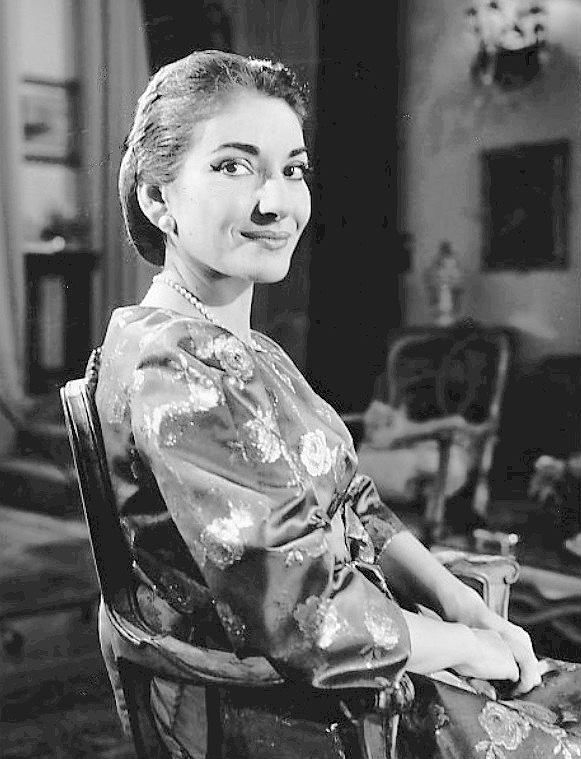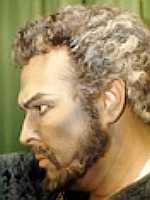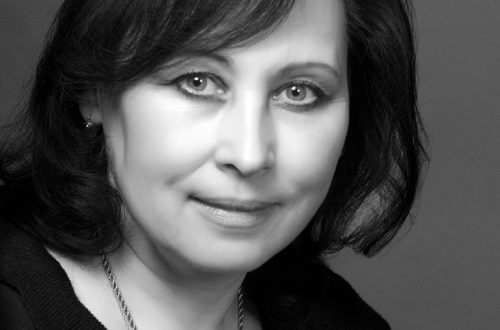
Maria Callas |
Maria Callas
One of the outstanding singers of the last century, Maria Callas, became a real legend during her lifetime. Whatever the artist touched, everything was lit up with some new, unexpected light. She was able to look at many pages of opera scores with a new, fresh look, to discover hitherto unknown beauties in them.
Maria Callas (real name Maria Anna Sophia Cecilia Kalogeropoulou) was born on December 2, 1923 in New York, in a family of Greek immigrants. Despite her small income, her parents decided to give her a singing education. Maria’s extraordinary talent manifested itself in early childhood. In 1937, together with her mother, she came to her homeland and entered one of the Athens conservatories, Ethnikon Odeon, to the famous teacher Maria Trivella.
- Maria Callas in the online store OZON.ru
Under her leadership, Callas prepared and performed her first opera part in a student performance – the role of Santuzza in the opera Rural Honor by P. Mascagni. Such a significant event took place in 1939, which became a kind of milestone in the life of the future singer. She moves to another Athens conservatory, the Odeon Afion, to the class of the outstanding Spanish coloratura singer Elvira de Hidalgo, who completed the polishing of her voice and helped Callas to take place as an opera singer.
In 1941, Callas made her debut at the Athens Opera, performing the part of Tosca in Puccini’s opera of the same name. Here she worked until 1945, gradually starting to master the leading opera parts.
Indeed, in the voice of Callas was a brilliant “wrongness”. In the middle register, she heard a special muffled, even somewhat suppressed timbre. Connoisseurs of vocals considered this a disadvantage, and listeners saw a special charm in this. It was no coincidence that they talked about the magic of her voice, that she captivates the audience with her singing. The singer herself called her voice “dramatic coloratura”.
The discovery of Callas took place on August 2, 1947, when an unknown twenty-four-year-old singer appeared on the stage of the Arena di Verona, the world’s largest open-air opera house, where almost all the greatest singers and conductors of the XNUMXth century performed. In the summer, a grandiose opera festival is held here, during which Callas performed in the title role in Ponchielli’s La Gioconda.
The performance was conducted by Tullio Serafin, one of the best conductors of Italian opera. And again, a personal meeting determines the fate of the actress. It is on the recommendation of Serafina that Callas is invited to Venice. Here, under his leadership, she performs the title roles in the operas “Turandot” by G. Puccini and “Tristan and Isolde” by R. Wagner.
It seemed that in the opera parts Kallas lives pieces of his life. At the same time, she reflected the fate of women in general, love and suffering, joy and sadness.
In the most famous theater in the world – Milan’s “La Scala” – Callas appeared in 1951, performing the part of Elena in “Sicilian Vespers” by G. Verdi.
The famous singer Mario Del Monaco recalls:
“I met Callas in Rome, shortly after her arrival from America, at the house of Maestro Serafina, and I remember that she sang several excerpts from Turandot there. My impression was not the best. Of course, Callas easily coped with all vocal difficulties, but her scale did not give the impression of being homogeneous. The mids and lows were guttural and the highs vibrated.
However, over the years, Maria Callas managed to turn her shortcomings into virtues. They became an integral part of her artistic personality and, in a sense, enhanced her performing originality. Maria Callas has managed to establish her own style. For the first time I sang with her in August 1948 at the Genoese theater “Carlo Felice”, performing “Turandot” under the direction of Cuesta, and a year later, together with her, as well as with Rossi-Lemenyi and maestro Serafin, we went to Buenos Aires …
… Returning to Italy, she signed a contract with La Scala for Aida, but the Milanese did not arouse much enthusiasm either. Such a disastrous season would break anyone but Maria Callas. Her will could match her talent. I remember, for example, how, being very short-sighted, she went down the stairs to the Turandot, groping for the steps with her foot so naturally that no one would ever guess about her shortcoming. Under any circumstances, she behaved as if she was fighting with everyone around her.
One February evening in 1951, sitting in the cafe “Biffy Scala” after the performance of “Aida” directed by De Sabata and with the participation of my partner Constantina Araujo, we were talking with the director of La Scala Ghiringelli and the general secretary of the Oldani Theater about what Opera is the best way to open the next season… Ghiringelli asked if I thought Norma would be suitable for the opening of the season, and I answered in the affirmative. But De Sabata still did not dare to choose the performer of the main female part … Severe by nature, De Sabata, like Giringelli, avoided trusting relationships with singers. Yet he turned to me with a questioning expression on his face.
“Maria Callas,” I answered without hesitation. De Sabata, gloomy, recalled the failure of Mary in Aida. However, I stood my ground, saying that in “Norma” Kallas would be a true discovery. I remembered how she won over the dislike of the audience of the Colon Theater by making up for her failure at Turandot. De Sabata agreed. Apparently, someone else had already called him the name Kallas, and my opinion was decisive.
It was decided to open the season also with the Sicilian Vespers, where I did not participate, since it was unsuitable for my voice. In the same year, the phenomenon of Maria Meneghini-Callas flared up as a new star in the world opera firmament. Stage talent, singing ingenuity, extraordinary acting talent – all this was bestowed by nature on Callas, and she became the brightest figure. Maria embarked on the path of rivalry with a young and equally aggressive star – Renata Tebaldi.
1953 marked the beginning of this rivalry, which lasted for a whole decade and divided the opera world into two camps.
The great Italian director L. Visconti heard Callas for the first time in the role of Kundry in Wagner’s Parsifal. Admired by the talent of the singer, the director at the same time drew attention to the unnaturalness of her stage behavior. The artist, as he recalled, was wearing a huge hat, the brim of which swayed in different directions, preventing her from seeing and moving. Visconti said to himself: “If I ever work with her, she won’t have to suffer so much, I’ll take care of it.”
In 1954, such an opportunity presented itself: at La Scala, the director, already quite famous, staged his first opera performance – Spontini’s Vestal, with Maria Callas in the title role. It was followed by new productions, including “La Traviata” on the same stage, which became the beginning of the worldwide fame of Callas. The singer herself wrote later: “Luchino Visconti marks a new important stage in my artistic life. I will never forget the third act of La Traviata, staged by him. I went on stage like a Christmas tree, dressed up like the heroine of Marcel Proust. Without sweetness, without vulgar sentimentality. When Alfred threw money in my face, I didn’t bend down, I didn’t run away: I remained on stage with outstretched arms, as if saying to the public: “Before you is a shameless one.” It was Visconti who taught me to play on stage, and I have deep love and gratitude for him. There are only two photographs on my piano – Luchino and soprano Elisabeth Schwarzkopf, who, out of love for art, taught us all. We worked with Visconti in an atmosphere of true creative community. But, as I have said many times, the most important thing is that he was the first to give me proof that my previous searches were correct. Scolding me for various gestures that seemed beautiful to the public, but contrary to my nature, he made me rethink a lot, approve the basic principle: maximum performing and vocal expressiveness with minimal use of movements.
Enthusiastic spectators awarded Callas with the title of La Divina – Divine, which she retained even after her death.
Quickly mastering all the new parties, she performs in Europe, South America, Mexico. The list of her roles is truly incredible: from Isolde in Wagner and Brunhilde in the operas of Gluck and Haydn to the common parts of her range – Gilda, Lucia in operas by Verdi and Rossini. Callas was called the revivalist of the lyrical bel canto style.
Her interpretation of the role of Norma in Bellini’s opera of the same name is noteworthy. Callas is considered one of the best performers of this role. Probably realizing her spiritual kinship with this heroine and the possibilities of her voice, Callas sang this part on many of her debuts – at Covent Garden in London in 1952, then on the stage of the Lyric Opera in Chicago in 1954.
In 1956, a triumph awaits her in the city where she was born – the Metropolitan Opera specially prepared a new production of Bellini’s Norma for Callas’ debut. This part, along with Lucia di Lammermoor in Donizetti’s opera of the same name, is considered by critics of those years to be among the artist’s highest achievements. However, it is not so easy to single out the best works in her repertory string. The fact is that Callas approached each of her new roles with extraordinary and even somewhat unusual responsibility for opera prima donnas. The spontaneous method was alien to her. She worked persistently, methodically, with full exertion of spiritual and intellectual forces. She was guided by the desire for perfection, and hence the uncompromisingness of her views, beliefs, and actions. All this led to endless clashes between Kallas and the theater administration, entrepreneurs, and sometimes stage partners.
For seventeen years, Callas sang almost without feeling sorry for herself. She performed about forty parts, performing on stage more than 600 times. In addition, she continuously recorded on records, made special concert recordings, sang on radio and television.
Callas regularly performed at Milan’s La Scala (1950-1958, 1960-1962), London’s Covent Garden Theater (since 1962), the Chicago Opera (since 1954), and the New York Metropolitan Opera (1956-1958). ). The audience went to her performances not only to hear the magnificent soprano, but also to see a real tragic actress. The performance of such popular parts as Violetta in Verdi’s La Traviata, Tosca in Puccini’s opera or Carmen brought her triumphant success. However, it was not in her character that she was creatively limited. Thanks to her artistic inquisitiveness, many forgotten examples of music of the XNUMXth-XNUMXth centuries came to life on the stage – Spontini’s Vestal, Bellini’s Pirate, Haydn’s Orpheus and Eurydice, Iphigenia in Aulis, and Gluck’s Alceste, The Turk in Italy and “Armida” by Rossini, “Medea” by Cherubini…
“Kallas’ singing was truly revolutionary,” writes L.O. Hakobyan, – she managed to revive the phenomenon of “limitless”, or “free”, soprano (ital. soprano sfogato), with all its inherent virtues, almost forgotten since the time of the great singers of the 1953th century – J. Pasta, M. Malibran, Giulia Grisi ( such as a range of two and a half octaves, richly nuanced sound and virtuoso coloratura technique in all registers), as well as peculiar “flaws” (excessive vibration on the highest notes, not always natural sounding of transitional notes). In addition to the voice of a unique, instantly recognizable timbre, Callas had a huge talent as a tragic actress. Due to excessive stress, risky experiments with her own health (in 3, she lost 30 kg in 1965 months), and also because of the circumstances of her personal life, the singer’s career was short-lived. Callas left the stage in XNUMX after an unsuccessful performance as Tosca in Covent Garden.
“I developed some standards, and I decided that it was time to part with the public. If I return, I will start all over again, ”she said at that time.
The name of Maria Callas nevertheless appeared again and again on the pages of newspapers and magazines. Everyone, in particular, is interested in the ups and downs of her personal life – marriage to the Greek multimillionaire Onassis.
Previously, from 1949 to 1959, Maria was married to an Italian lawyer, J.-B. Meneghini and for some time acted under a double surname – Meneghini-Kallas.
Callas had an uneven relationship with Onassis. They converged and diverged, Maria was even going to give birth to a child, but could not save him. However, their relationship never ended in marriage: Onassis married the widow of US President John F. Kennedy, Jacqueline.
Restless nature attracts her to unknown paths. So, she teaches singing at the Juilliard School of Music, puts on Verdi’s opera “Sicilian Vespers” in Turin, and is filming in 1970 the film “Medea” by Paolo Pasolini …
Pasolini wrote very interestingly about the acting style of the actress: “I saw Callas – a modern woman in whom an ancient woman lived, strange, magical, with terrible internal conflicts.”
In September 1973, the “postlude” of Kallas’ artistic career began. Dozens of concerts in different cities of Europe and America were again accompanied by the most enthusiastic applause of the audience. Captious reviewers, however, caustically noticed that the applause was more addressed to the “legend” than to the singer of the 70s. But all this did not bother the singer. “I have no harsher critic than myself,” she said. – Of course, over the years I have lost something, but I have gained something new … The public will not applaud only the legend. She probably applauds because her expectations were met in one way or another. And the court of the public is the fairest … “
Perhaps there is no contradiction at all. We agree with the reviewers: the audience met and saw off the “legend” with applause. But the name of this legend is Maria Callas…





